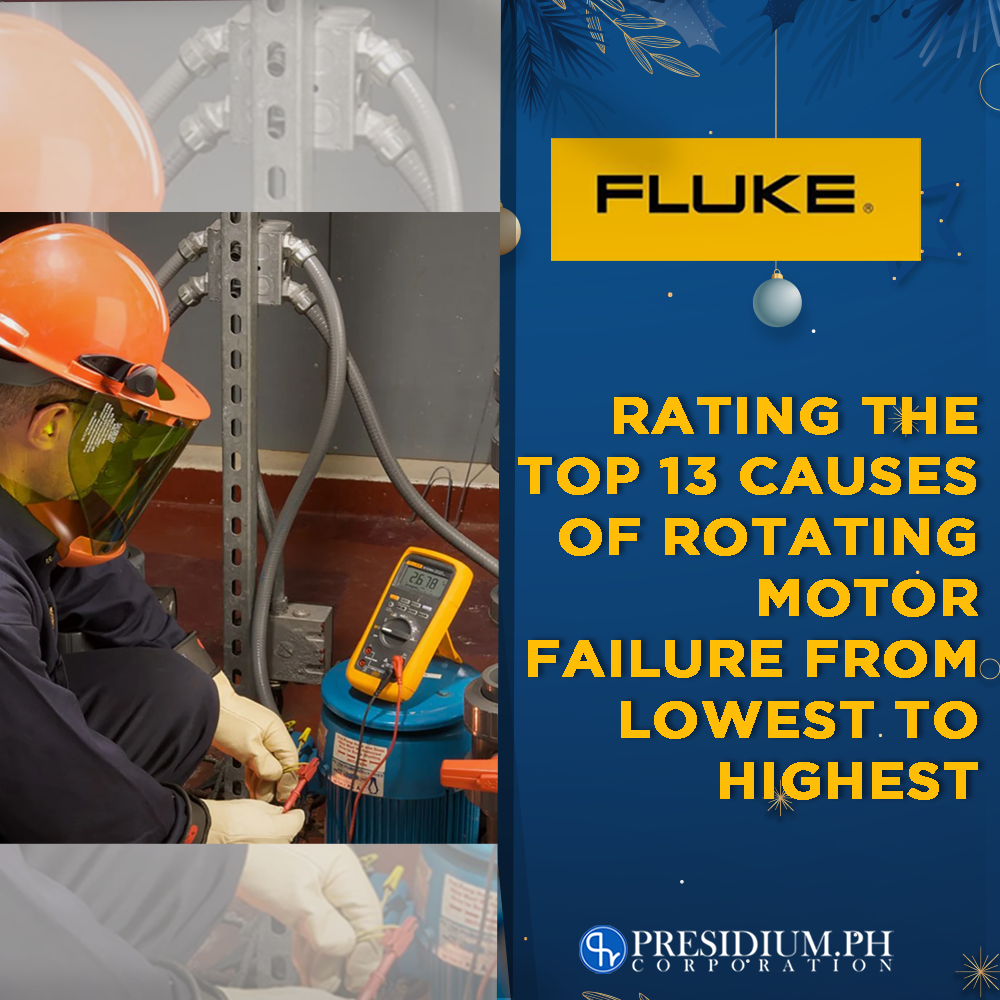Top 13 Causes of Rotating Motor Failure from Lowest to Highest

The number one priority of maintenance men is to focus on machine faults, errors, or defects and stop them before they even happen. After diagnosing the machine, they will then settle on the most suitable tool to get the job done.
However, considering rotating machines, things can always get a tad bit tricky. These kinds of machines are prone to imbalance, looseness, misalignment, and wear. Naturally, the best way to deal with them is by having regular checkups with the most trusted test tool in the industrial department, and those are Fluke test tools.
But first, here is the top thirteen causes of motor failure…
Motors are saturated everywhere especially in industrial departments. However, over time, these motors are also prone to malfunction and eventually slow down. Naturally, they become more complex and technical which may prove to be a challenge for maintenance men to fix without the right tools. Let us delve into the top thirteen causes of motor failure for better understanding.
Rotating Motor Failure: Power Quality
- Transient voltage
The impact? Motor winding insulation. Technically, it is going to break down leads that will lead to motor failure and will eventually lead to long downtimes.
Criticality status – High
- Voltage imbalance
The impact? This will create an excessive current flow. It will impact one or more phases that will increase operating temperatures. In the end, it will lead to insulation breakdown.
Criticality status – Medium
- Harmonic distortion
The impact? Briefly, what happens is a decrease in motor efficiency. You see, harmonic distortion is additional energy that is used in the motor shaft. However, this kind of energy also contributes to internal energy losses that are bad for the machine. It can come in the form of heat and over time will cause deterioration of the insulation of the windings.
Criticality status – Medium
Rotating Motor Failure: Variable Frequency Drives
- Reflections on drive output PWM signals
The impact? Motor winding insulation breakdown. This is also the works of impedance mismatches that root out from improper installation, improper component selection, or equipment degradation over time.
Criticality status – High
- Sigma current
The impact? Mysterious circuit trip caused by protective earth current flow.
Criticality status – Low
- Operational overloads
The impact? This might do permanent failure to your machine since it causes premature wear on motor electrical and mechanical components.
Criticality status – High
Rotating Motor Failure: Mechanical Faults
- Misalignment
The impact? There are three types of misalignments that could occur. This is angular misalignment, parallel misalignment, and compound misalignment. All of which leads to premature wear in mechanical drive components.
Criticality status – High
- Shaft imbalance
The impact? This may be caused by a lot of factors such as dust accumulation, missing balance weights, manufacturing variations, and a lot more. This will result in premature wear in mechanical drive components and total mechanical failure.
Criticality status – High
- Shaft looseness
The impact? You see, a looseness that is caused by the actual rotation might stem out from excessive clearance between rotating and stationary elements. This can also result in premature wear and failure.
Criticality status – High
- Bearing wear
The impact? Remember that this can also cause by several things. These are:
- A heavier load than designed for
- Inadequate or incorrect lubrication
- Ineffective bearing sealing
- Shaft misalignment
- Incorrect fit
- Normal wear
- Induced shaft voltages
Ultimately, accelerated wear on rotating components can result in bearing failure.
Criticality status – High
Rotating Motor Failure: Improper Installation Factors
- Soft foot
The impact? There are two types of “soft foot” that you need to know about. There is a parallel soft foot and angular soft foot. Parallel soft foot takes place when one of the mounting feet is higher than the other three. Meanwhile, angular soft foot happens when one of the mounting feet is not parallel or “normal” to the mounting surface. But in totality, it heavily makes an impact on the misalignment of mechanical drive components.
Criticality status – Medium
- Pipe strain
The impact? This will generally put a strain on rotating components and will cause shaft misalignments. Naturally, this will also result in premature failures.
Criticality status – Low
- Shaft voltage
The impact? Arcing across bearing surfaces create pitting and fluting resulting in excessive vibration and eventual bearing failure
Criticality status – High
Resolve these failures using Fluke Tools!
Hey, we made it to the bottom! Are you currently looking for the best-performing test tools in the market to run daily maintenance checks on your rotating machines? Presidium PH is an authorized distributor of Fluke test tools in the Philippines. Prevent these faults from penetrating your rotating machine by using the best test tools there are!
If you want to know more about Fluke tools and their functions, visit our website for more info! This is a one-stop shop for the best test tools within Metro Manila.





